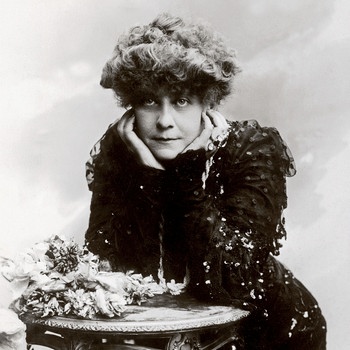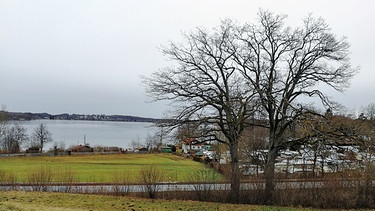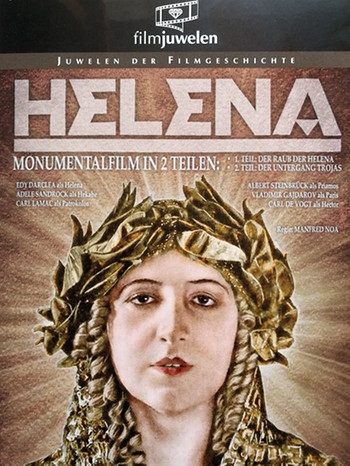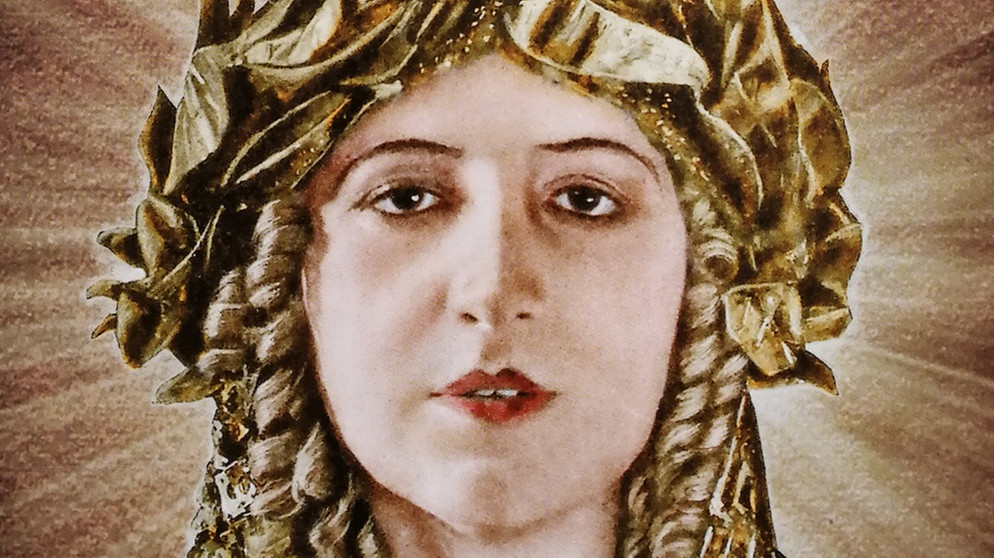“Helena” was the first, most elaborate and extensive film adaptation of the ancient material in Germany. The silent film was made in 1923, in the midst of an unprecedented year of crisis: the occupation of the Ruhr area by French troops and separatist tendencies in the west and south of the German Reich threatened the existence of the young Weimar Republic.
Hyperinflation wiped out national wealth and paralyzed the economy. On November 9th, Hitler and Ludendorff finally tried to overthrow the Berlin Reich government: the Munich Hitler putsch triggered a political earthquake.
Against this background, “Helena” was created in and around Munich. The monumental film was made in a city that was not exactly the center of the film world at that time. Because at that time the center of the young German film industry was Berlin. The main actor there: Ufa.
–
Cinema in Munich in the 1920s: “Emelka” and “Bavaria Filmhaus AG”
–
Poster on “Ben Hur” (1925)
–
Following the example of Ufa, in 1918 the Munich photographer and film pioneer Peter Ostermayr set up the “Münchner Lichtspielkunst”, or Em-el-ka for short, in the Bavarian capital. Other production companies soon joined the expanding Emelka Group, including Erich Wagowski’s Bavaria Filmhaus AG.
Wagowski planned monumental things: together with the Berlin director Manfred Noa, he wanted to film Homer. He sensed his chance to overtake the American competition, who had already started filming “Ben Hur”, with a similar project.
Soon after the invention of the cinema at the end of the 19th century, the myths of antiquity were discovered for the screen. The idea: upscale fabrics should polish up the image of the new medium.
–
The silent film Helena: First-class cast of the leading roles

–
Adele Sandrock, German-Dutch actress (1890)
–
A squad of international leading actors such as the Italian Edy Darclea as Helena, Wladimir Gaidarow as Paris and Adele Sandrock as Hecabe should also contribute to the success of the film project. There were also several thousand extras and numerous animals, including oxen, cattle, horses, donkeys and two lions.
The production costs of “Helena” were ten billion Reichsmarks at the start of production. A seemingly gigantic sum. In those weeks of the simultaneous onset of hyperinflation, it was equivalent to about $ 100,000.
–
“At the beginning of the 1920s, the film was considered a gold mine in Germany. It was like the new media today. You put money in and more money comes out. That means that industrial companies and all kinds of patrons invested there. There were investments that seemed completely impossible. I know of investors who used their wife’s legacy. That was a real hype! “
(Rolf Giesen, film historian)
–
–
–
Temple festivals in Schwabing and a Trojan horse on Lake Wörth
The large-scale production of Bavaria AG blew up everything that had come before: Director Manfred Noa staged a spectacular chariot race on a disused horse racing track in the north of Munich. Opulent temple festivals were staged, a lion hunt near Wolfratshausen, a huge sea battle with 80 ships – on the Wörthsee.
Using a true-to-scale wooden horse in front of a specially built city wall, the downfall of Troy took place there, and some contributors were paid for in beer and wood amid the prevailing hyperinflation.
–

–
Kathe Hartmann
–
“In the Reichsfilmblatt you could read that the Bavaria-Filmgesellschaft had built a huge city out of the ground outside Munich on the Wörthsee, reminiscent of Los Angeles in California. The huts of Sparta were at the current bathing place at the Seewirtschaft. Small and covered with rushes. On top of the Grünbichl there was a massive castle. The two oaks below were the sacrificial altar. At night the whole splendor was guarded by the night watchman, baker Karl from Schlagenhofen. “
(Käthe Hartmann, granddaughter of a contemporary witness)
–
–
–
The premiere of “Helena” took place in the film capital Berlin
“Der Raub der Helena” was premiered not in Munich, the place where it was made, but in Berlin on February 4, 1924.
–
“If a film did not have a Berlin premiere, it was considered secondary. So it was actually a duty that the premiere should take place in the Reich capital, for reasons of prestige.”
(Rolf Giesen, film historian)
–
–
–
The Berlin audience and the press were equally enthusiastic about “Helena”. In Munich, “Helena” was launched four weeks later, on March 6, 1924, in the Kammerlichtspiele in Kaufingerstrasse. And here too the film was a great success: 40,000 visitors in three and a half weeks. This made “Helena” more popular than the German monumental films “INRI” by Robert Wiene, which were running at the same time, about the life of Jesus and Fritz Lang’s “The Nibelungs”.
–
But Wagowski hoped in vain: he was able to sell the film to most European countries and even to Japan. For the most important market, the USA, he could not win a well-known distributor for his competing project for “Ben Hur”.
–
“The film would definitely have been a success in America. It was not a success because Noa and Wagowski had the goal of going against American film, against, and the Americans must have responded with a tacit boycott.”
(Rolf Giesen, film historian)
–
–
–
To make matters worse: the currency reform of autumn 1923 ended the phase of hyperinflation, but paralyzed the export of German films due to the new, less favorable exchange rate.
–
“From that moment on it was anyway uninteresting to buy films of this kind. It had been done before, it promised an economic success, then fewer and fewer German films came onto the international market.”
(Rolf Giesen, film historian)
–
–
–
A financial disaster for producer Erich Wagowski, whose Bavaria Filmhaus had to file for bankruptcy in February 1925. Then he tried a new production company, but also suffered financial shipwreck with it. In May 1927, Erich Wagowski shot himself at the age of 34.
–
Director Manfred Noa left the city after the Munich premiere of “Helena” and returned to Berlin.
–
Munich’s foundation stone as a film city: what became of “Helena”?
“Helena”, one of the cornerstones of Munich as a film city, fell into oblivion and was considered lost for decades. What remained, for now, were memories that sounded like a fairy tale to those who were born later:
–

–
The scene of the Battle of Troy: Lake Wörthsee, quiet and peaceful in 2021. If you are lucky, you can still find props today.
–
“In the 60s and 70s, the older people enthusiastically talked about the big event that turned the dreamy Schlagenhofen into a big film location for one summer. And every now and then someone pulled an old beer mug or a wooden sword from the mud of the Wörthsee. “
(Käthe Hartmann, daughter of a contemporary witness)
–
–
–
In 1999 the tide turned. The Cinémathèque Suisse discovered an incomplete Swiss copy of “Helena” with Franco-German subtitles in its holdings.
–
The treasure was handed over to the Munich Film Museum. From here the worldwide search for further copies began. The missing opening sequence was discovered in Italy, a fragment of the second part in London. Scene by scene was reconstructed and supplemented, finds from Spain and Russia were added.
–
Then it was done: only five of 210 film minutes were probably lost forever. In 2001 “Helena” was available again as a reconstruction of the original film and was broadcast on television. A rebirth – almost 80 years after its creation.
–
DVD tip:

–
–
Helena – monumental film in 2 parts
1st part: The robbery of Helena
Part 2: The Fall of Troy
Copyright 2016: Filmverlag Fernsehjuwelen
Director: Manfred Noa
Running time: 3 hours and 34 minutes
Actors: Edy Darclea, Wladimir Gaidarow, Hanna Ralph, Adele Sandrock, Albert Steinrück, Albert Bassermann
Release Date: May 16, 2016
Language: German (Dolby Digital 2.0)
Studio: Alive – Sales and Marketing / DVD
SALT: B019G8STC2
Number of discs: 1
–
–
–


